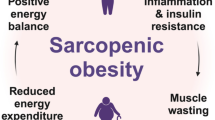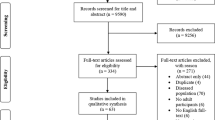Abstract
Objective
To assess the reliability and validity of Turkish version of SARC-F in regard to screening with current definitions of sarcopenia, muscle mass and functional measures.
Design
Cross-sectional study.
Participants
Community-dwelling older adults aged >=65 years admitting to a geriatric outpatient clinic.
Measurements
Muscle mass (bioimpedance analysis), handgrip strength, usual gait speed, chair sit-to-stand test, functional reach test, short physical performance battery, SARC-F questionnaire, FRAIL questionnaire Sarcopenia was evaluated with 4 current different definitions: European Working Group on Sarcopenia in Older People’s (EWGSOP); Foundation for the National Institutes of Health (FNIH), International Working Group on Sarcopenia (IWGS) and Society on Sarcopenia, Cachexia and Wasting Disorders (SCWD).
Results
After cross-cultural adaptation, 207 subjects were analysed in the clinical validation study. Mean age was 74.6±6.7 years, 67.6% were women. Against EWGSOP, FNIH, IWGS and SCWD definitions of sarcopenia, sensitivity of SARC-F were %25, 31.6%, 50% and 40%; specificity were 81.4%, 82.4%, 81.8% and 81.7%, respectively. Positive predictive values were between 5.1-15.4% and negative predictive values were 92.3-98.2%. Against parameters of low muscle mass, sensitivity were about 20% and specificity were about 81%. Against parameters of function; for low hand grip strength, sensitivity of SARC-F were 33.7% (for Turkish cut-off); 50% (for FNIH cut-off); specificity were 93.7% (for Turkish cut-off) and 85.8% (for FNIH cut-off). Against low UGS, poor performance in chair sit to stand test, functional reach test, SPPB and presence of positive frailty screening sensitivity were 58.3%, 39.2%, 59.1%, 55.2% and 52.1% while specificity were 97.3%, 97.8%, 88.1%, 99.3% and 91.2%, respectively.
Conclusion
The psychometric performance of Turkish SARC-F was similar to the original SARC-F. It revealed low sensitivity but high specificity with all sarcopenia definitions. Sensitivity and specificity were higher for muscle function tests reflecting its inquiry and input on functional measures. Our findings suggest that SARC-F is an excellent test to exclude muscle function impairment and sarcopenia. SARC-F is relatively a good screening test for functional measures.


Similar content being viewed by others
References
Tan LF, Lim ZY, Choe R, et al. Screening for frailty and sarcopenia among older persons in medical outpatient clinics and its associations with health care burden. J Am Med Dir Assoc 2017;24:583–587.
Beaudart C, Mc Closkey E, Bruye`re O, et al. Sarcopenia in daily practice: assessment and management. BMC Geriatr 2016;16:170.
Bahat G, Yilmaz O, Oren M, et al. Cross-cultural adaptation and validation of the SARC-F to assess sarcopenia: methodological report from European Union Geriatric Medicine Society Sarcopenia Special Interest Group. Eur Geriatr Med 2018;9:23–28.
Malmstrom TK, Morley JE. SARC-F: a simple questionnaire to rapidly diagnose sarcopenia. J Am Med Dir Assoc 2013;14:531–532.
Parra-Rodriguez L, Szlejf C, Garci´a-Gonza´lez AI, et al. Cross-cultural adaptation and validation of the Spanish-language version of the SARC-F to assess sarcopenia in Mexican community-dwelling older adults. J Am Med Dir Assoc 2016;17:1142–1146
Ida S, Murata K, Nakadachi D, et al. Development of a Japanese version of the SARC-F for diabetic patients: an examination of reliability and validity. Aging Clin Exp Res 2017;29:935–942.
Barbosa-Silva TG, Menezes AMB, Bielemann, RM, et al. Enhancing SARC-F: Improving sarcopenia screening in the clinical practice. J Am Med Dir Assoc 2016;17:1136–1141.
Kemmler W, Sieber C, Freiberger E, et al. The SARC-F Questionnaire: Diagnostic Overlap with Established Sarcopenia Definitions in Older German Men with Sarcopenia. Gerontology 2017;63:411–416
Charlotte B, Medea L, Stephen B, et al. French translation and validation of the sarcopenia screening tool SARC-F. Eur Geriatr Med 2018;9.1:29–37
Kim S, Kim M, Won CW. Validation of the Korean version of the SARC-F questionnaire to assess sarcopenia: Korean frailty and aging cohort study. J Am Med Dir Assoc 2018;19:40–45.
WHO. Process of translation and adaptation of instruments. https://doi.org/www.who.int/substance_abuse/research_tools/translation/en/. Accessed on April 8, 2018.
Katz S, Ford AB, Moskowitz RW, et al. Studies of illness in the aged. The Index of Adl: a standardized measure of biological and psychosocial function. JAMA 1963;185:914–9.
Lawton MP, Brody EM. Assessment of older people: self-management. Gerontologist 1969;9:179–86.
Rabin R, de Charro F. EQ-5D: a measure of health status from the EuroQol Group. J Ann Med 2001;33:337–43.
Guigoz Y, Vellas B, Garry PJ. Assessing the nutritional status of the elderly: The Mini Nutritional Assessment as part of the geriatric evaluation. Nutr Rev 1996;54:59–65.
Cho YC, Alessi CA, Cho M et al. The association between chronic illness and functional change among participants in Comprehensive Geriatric Assessment Program. J Am Geriatr Soc 1998; 46:677–682.
Cruz-Jentoft AJ, Baeyens JP, Bauer JM, et al. Sarcopenia: European consensus on definition and diagnosis: Report of the European Working Group on Sarcopenia in Older People. Age Ageing 2010;39:412–423.
Studenski SA, Peters KW, Alley DE, et al. The FNIH sarcopenia project: rationale, study description, conference recommendations, and final estimates J Gerontol A Biol Sci Med Sci 2014;69:547–558.
Fielding RA, Vellas B, Evans WJ, et al. Sarcopenia: An undiagnosed condition in older adults. Current consensus definition: Prevalence, etiology, and consequences. International Working Group on Sarcopenia. J Am Med Dir Assoc 2011;12:249–256.
Morley JE, Abbatecola AM, Argiles JM, et al. Sarcopenia with limited mobility: an international consensus. J Am Med Dir Assoc 2011;12:403–409.
Buatois S, Perret-Guillaume C, Gueguen R, Miget P, et al. A simple clinical scale to stratify risk of recurrent falls in community-dwelling adults aged 65 years and older. Phys Ther 2010;90:550–60.
Atsuhiro T, Masayoshi K, Ryosaku K, et al. Age-Related Changes in Physical Function in Community-Dwelling People Aged 50–79 Years. J Phys Ther Sci 2010;22:23–27.
Working Group on Functional Outcome Measures for Clinical Trials. Functional outcomes for clinical trials in frail older persons: time to be moving. J Gerontol A Biol Sci Med Sci 2008;63:160–4.
Guralnik JM, Simonsick EM, Ferrucci L, et al. A short physical performance battery assessing lower extremity function: association with self-reported disability and prediction of mortality and nursing home admission. J Gerontol 1994;49:85–94
Duncan PW, Studenski S, Chandler J, et al. Functional reach: predictive validity in a sample of elderly male veterans. J Gerontol 1992;47:93–98.
Morley JE, Malmstrom TK, Miller DK. A simple frailty questionnaire (FRAIL) predicts outcomes in middle aged African Americans. J Nutr Health Aging 2012;16:601–608.
Nunnally JC, Bernstein I. Psychometric theory, 3. Ed. New York: McGrawHill Inc, 1994.
Woo J, Leung J, Morley JE. Validating the SARC-F: a suitable community screening tool for sarcopenia? J Am Med Dir Assoc 2014;15:630–634
Yang M, Hu X, Xie, L, et al. Screening Sarcopenia in Community-Dwelling Older Adults: SARC-F vs SARC-F Combined With Calf Circumference (SARC-CalF). J Am Med Dir Assoc 2018;19:277–278.
Ishiyama D, Yamada M, Makino A, et al. The cut-off point of short physical performance battery score for sarcopenia in older cardiac inpatients. Eur Geriatr Med 2017;8:299–303.
Author information
Authors and Affiliations
Corresponding author
Electronic supplementary material
Supplementary Table 1
. English and Turkish versions of the SARC-F.
Rights and permissions
About this article
Cite this article
Bahat, G., Yilmaz, O., Kiliç, C. et al. Performance of SARC-F in Regard to Sarcopenia Definitions, Muscle Mass and Functional Measures. J Nutr Health Aging 22, 898–903 (2018). https://doi.org/10.1007/s12603-018-1067-8
Received:
Accepted:
Published:
Issue Date:
DOI: https://doi.org/10.1007/s12603-018-1067-8




